190th Street station
The 190th Street station (originally 190th Street–Overlook Terrace) is a station on the IND Eighth Avenue Line of the New York City Subway, served by the A train at all times. It is located on Fort Washington Avenue in the Hudson Heights section of Manhattan's Washington Heights neighborhood, near the avenue's intersection with Cabrini Boulevard at Margaret Corbin Circle, about three blocks north of 190th Street.
190 Street | ||||||||||||||||||||||||||||||||||||||||||||||||||||||||||||||||||||
|---|---|---|---|---|---|---|---|---|---|---|---|---|---|---|---|---|---|---|---|---|---|---|---|---|---|---|---|---|---|---|---|---|---|---|---|---|---|---|---|---|---|---|---|---|---|---|---|---|---|---|---|---|---|---|---|---|---|---|---|---|---|---|---|---|---|---|---|---|
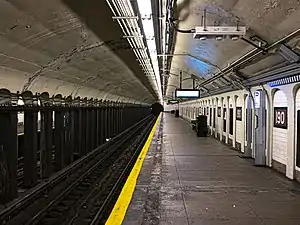 Southbound platform | ||||||||||||||||||||||||||||||||||||||||||||||||||||||||||||||||||||
| Station statistics | ||||||||||||||||||||||||||||||||||||||||||||||||||||||||||||||||||||
| Address | West 190th Street & Fort Washington Avenue New York, NY 10040 | |||||||||||||||||||||||||||||||||||||||||||||||||||||||||||||||||||
| Borough | Manhattan | |||||||||||||||||||||||||||||||||||||||||||||||||||||||||||||||||||
| Locale | Washington Heights, Hudson Heights | |||||||||||||||||||||||||||||||||||||||||||||||||||||||||||||||||||
| Coordinates | 40.8590°N 73.9340°W | |||||||||||||||||||||||||||||||||||||||||||||||||||||||||||||||||||
| Division | B (IND)[1] | |||||||||||||||||||||||||||||||||||||||||||||||||||||||||||||||||||
| Line | IND Eighth Avenue Line | |||||||||||||||||||||||||||||||||||||||||||||||||||||||||||||||||||
| Services | A | |||||||||||||||||||||||||||||||||||||||||||||||||||||||||||||||||||
| Transit | ||||||||||||||||||||||||||||||||||||||||||||||||||||||||||||||||||||
| Structure | Underground | |||||||||||||||||||||||||||||||||||||||||||||||||||||||||||||||||||
| Depth | 140 feet (43 m)[2] | |||||||||||||||||||||||||||||||||||||||||||||||||||||||||||||||||||
| Platforms | 2 side platforms | |||||||||||||||||||||||||||||||||||||||||||||||||||||||||||||||||||
| Tracks | 2 | |||||||||||||||||||||||||||||||||||||||||||||||||||||||||||||||||||
| Other information | ||||||||||||||||||||||||||||||||||||||||||||||||||||||||||||||||||||
| Opened | September 10, 1932[3] | |||||||||||||||||||||||||||||||||||||||||||||||||||||||||||||||||||
| Accessible | ||||||||||||||||||||||||||||||||||||||||||||||||||||||||||||||||||||
| Opposite- direction transfer | Yes | |||||||||||||||||||||||||||||||||||||||||||||||||||||||||||||||||||
| Former/other names | 190th Street–Overlook Terrace | |||||||||||||||||||||||||||||||||||||||||||||||||||||||||||||||||||
| Other entrances/ exits | east side of Fort Washington Avenue, west side of Bennett Avenue | |||||||||||||||||||||||||||||||||||||||||||||||||||||||||||||||||||
| Traffic | ||||||||||||||||||||||||||||||||||||||||||||||||||||||||||||||||||||
| 2019 | 1,535,450[4] | |||||||||||||||||||||||||||||||||||||||||||||||||||||||||||||||||||
| Rank | 292 out of 424[4] | |||||||||||||||||||||||||||||||||||||||||||||||||||||||||||||||||||
| ||||||||||||||||||||||||||||||||||||||||||||||||||||||||||||||||||||
| ||||||||||||||||||||||||||||||||||||||||||||||||||||||||||||||||||||
| ||||||||||||||||||||||||||||||||||||||||||||||||||||||||||||||||||||
| ||||||||||||||||||||||||||||||||||||||||||||||||||||||||||||||||||||
| ||||||||||||||||||||||||||||||||||||||||||||||||||||||||||||||||||||
190th Street Subway Station (IND) (190th Street-Overlook Terrace Subway Station) | ||||||||||||||||||||||||||||||||||||||||||||||||||||||||||||||||||||
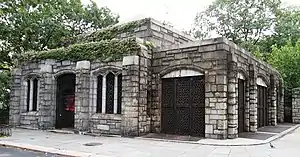 Ft. Washington Ave. entrance building (2014) | ||||||||||||||||||||||||||||||||||||||||||||||||||||||||||||||||||||
| MPS | New York City Subway System MPS | |||||||||||||||||||||||||||||||||||||||||||||||||||||||||||||||||||
| NRHP reference No. | 05000225[5] | |||||||||||||||||||||||||||||||||||||||||||||||||||||||||||||||||||
| Added to NRHP | March 30, 2005 | |||||||||||||||||||||||||||||||||||||||||||||||||||||||||||||||||||
The 190th Street station opened in 1932 and has two tracks and two side platforms. It is close to Fort Tryon Park with the Cloisters medieval art museum, and the Mother Cabrini Shrine. An additional exit through the side of the hill leads to Bennett Avenue and provides access to the Broadway Valley area of Washington Heights. The station is listed on the National Register of Historic Places.
History
Construction and opening
New York City mayor John Francis Hylan's original plans for the Independent Subway System (IND), proposed in 1922, included building over 100 miles (160 km) of new lines and taking over nearly 100 miles (160 km) of existing lines. The lines were designed to compete with the existing underground, surface, and elevated lines operated by the Interborough Rapid Transit Company (IRT) and BMT.[6][7] On December 9, 1924, the New York City Board of Transportation (BOT) gave preliminary approval for the construction of the IND Eighth Avenue Line.[8] This line consisted of a corridor connecting Inwood, Manhattan, to Downtown Brooklyn, running largely under Eighth Avenue but also paralleling Greenwich Avenue and Sixth Avenue in Lower Manhattan.[8][9] The BOT announced a list of stations on the new line in February 1928, with a station at 190th Street.[10]
The BOT began constructing the 190th Street station in 1928. Squire J. Vickers, the chief architect of the Dual System, helped design the 190th Street station. He was responsible for most stations on the Independent Subway System (IND), and being a painter, he did tile work for the station.[5]: 9 Robert Ridgway was hired as the chief engineer.[5]: 10 The finishes at the five stations between 175th and 207th Street, including the 190th Street station, were 18 percent completed by May 1930.[11] By that August, the BOT reported that the Eighth Avenue Line was nearly completed and that the stations from 116th to 207th Street were 99.9 percent completed.[12] The entire line was completed by September 1931, except for the installation of turnstiles.[13]
A preview event for the new subway was hosted on September 8, 1932, two days before the official opening.[14][15] The 190th Street station opened on September 10, 1932, as part of the city-operated IND's initial segment, the Eighth Avenue Line between Chambers Street and 207th Street.[16][17] Construction of the whole line cost $191.2 million. Service at this station was provided with express service from its onset. While the IRT Broadway–Seventh Avenue Line already provided service to Washington Heights, the new subway via Fort Washington Avenue made subway service more readily accessible.[18] Its opening resulted in the development of residential apartment buildings south of the station.[5]: 10
Operation
On December 28, 1950, the Board of Transportation issued a report concerning the construction of bomb shelters in the subway system. Five deep stations in Washington Heights, including the 190th Street station, were considered to be ideal for being used as bomb-proof shelters. The program was expected to cost $104 million. These shelters were expected to provide limited protection against conventional bombs, while providing protection against shock waves and air blast, as well as from the heat and radiation from an atomic bomb. To become suitable as shelters, the stations would require water-supply facilities, first-aid rooms, and additional bathrooms.[19][20] However, the program, which required federal funding, was never completed.[21]
In 1951, researchers from New York University concluded that in the event of a nuclear attack, the 190th Street station would provide adequate shelter from fallout. This was ascertained after the researchers conducted tests on cosmic rays inside deep subway stations in the area.[22]
The 190th Street station is mostly unchanged from its original design.[5]: 8 On March 30, 2005, the 190th Street station was listed on the National Register of Historic Places.[5] The station was considered historically and architecturally significant as an early IND station that retained many of its original features.[5]: 9
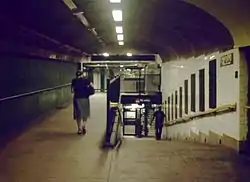
Elevator modifications
From 1932 until 1957, pedestrians had to pay a fare to use the elevators. Though the elevators were intended for subway riders, local residents paid the subway fare to avoid climbing about eight stories up Fort Washington Hill. Bills were proposed in the New York State Legislature to put the elevators out of fare control, but these failed in committee. On September 5, 1957, the New York City Transit Authority (NYCTA) began allowing free public access to the elevators at the 181st and 190th Street stations. The NYCTA agreed once Joseph Zaretzki, the local State Senator, requested the change.[23]
Several of the elevators in the station are staffed by elevator attendants, who are also employed at four other deep-level stations in Washington Heights. The elevator attendants are intended to reassure passengers, as the elevators are the only entrance to the platforms, and passengers often wait for the elevators with an attendant.[24] The attendants at the five stations are primarily maintenance and cleaning workers who suffered injuries that made it hard for them to continue doing their original jobs.[25][26] In July 2003, to reduce costs, the Metropolitan Transportation Authority (MTA) announced that as part of its 2004 budget it would eliminate 22 elevator operator positions at the 190th Street station and four others in Washington Heights, leaving one full-time operator per station.[26] The agency had intended to remove all the attendants at these stops, but kept one in each station after many riders protested.[27][28] In addition, the MTA began operating all elevators at all times; prior to the change, each elevator only operated if it was staffed by an elevator operator.[29] The change took effect on January 20, 2004,[30] and was expected to save $1.15 million a year.[29]
In November 2007, the MTA proposed savings cuts to help reduce the agency's deficit. As part of the plan, all elevator operators at 190th Street, along with those in four other stations in Washington Heights, would have been cut.[31][32] MTA employees had joined riders in worrying about an increase in crime as a result of the cuts after an elevator operator at 181st Street on the Broadway–Seventh Avenue Line helped save a stabbed passenger.[33] The move was intended to save $1.7 million a year. However, on December 7, 2007, the MTA announced that it would not remove the remaining elevator operators at these stations, due to pushback from elected officials and residents from the area.[34] In October 2018, the MTA once again proposed removing the elevator operators at the five stations, but this was reversed after dissent from the Transport Workers' Union.[35] The MTA again suggested reassigning elevator operators to station-cleaner positions in June 2023,[36][37] prompting local politicians to sue to prevent the operators' reassignments.[25][38]
This station's elevators were closed for elevator replacement on August 29, 2020, but the station remained open via the exit to Bennett Avenue. The elevators were scheduled to reopen in September 2021.[39][40][41] Some of the elevators reopened on November 30, 2021; the reopening was pushed back due to unexpected structural issues.[42]
Station layout
| G | Street level | Exit/entrance Bank of elevators in southern exit. Note: Platforms and street level are not accessible |
| M | Mezzanine | Fare control, station agent, MetroCard machines, tunnel to Bennett Avenue |
| P Platform level |
Side platform | |
| Northbound | ← | |
| Southbound | | |
| Side platform | ||
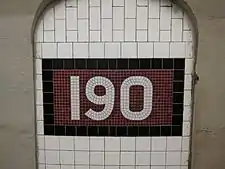
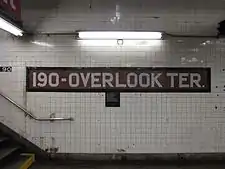
The station has two tracks and two side platforms.[43] It is the third-to-last station on the IND Eighth Avenue Line proceeding northbound.[44] The station's platforms are 660 feet (200 m) long, a typical length of station platforms built by the Independent Subway System, and the station itself is 50 feet (15 m) wide. The platform level contains a double-barrel-vaulted ceiling supported by an arcade in the center. The ceiling is relatively low, in contrast to other nearby deep-level stations such as 181st Street or 168th Street stations on the IRT Broadway–Seventh Avenue Line, where the vaults are larger.[5]: 5
The outer walls of the platform level consist of tiled alcoves, slightly recessed within concrete arches. The station's tiles are colored maroon.[5]: 6 This was part of a color-coded tile system used throughout the IND.[45] The tile colors were designed to facilitate navigation for travelers going away from Lower Manhattan. As such, the maroon tiles used at the 190th Street station are also used at 168th Street, the first express station to the south, as well as at other stations on the Eighth Avenue Line north of 168th Street.[46][47] Maroon-and-black plaques with white sans-serif lettering reading "190-OVERLOOK TER." are located on the walls nearest the stairways to the mezzanine. Smaller maroon, black, and white mosaics with the number "190" are located within some of the alcoves. Within the alcoves that do not contain the "190" mosaic, there are black tiles with white numerals reading "190". The remaining tiling in the alcoves is white.[5]: 6 A ramp leads from the northbound platform to an exit passageway leading to Bennett Avenue.[48]
A small concrete-floored mezzanine is located above the platforms toward the northern end of the station. The portion of the mezzanine above the platforms has metal railings on its northern and southern sides, from which the platforms can be seen. The rest of the mezzanine has white tiled walls. Two stairs descend from the mezzanine to each platform. There is also a station-agent booth on the northern wall.[5]: 7
Located 140 feet (43 m) below ground level, it is one of the deepest stations in the entire system by distance to ground level; it is even deeper than the 34th Street–Hudson Yards station, the deepest station in the system by elevation below sea level.[2][lower-alpha 1] Although this is an extremely deep station, the Bennett Avenue entrance is at a lower elevation than the platforms, so the ramp slopes down.[50][51] Additionally, Dyckman Street, the next station north, is only one level below the surface, in contrast to the 190th Street station.[52]
Entrances and exits
Contrary to the station's name, there are no exits to either 190th Street or Overlook Terrace. However, the station has entrances both to Hudson Heights, on top of the ridge, and to Bennett Avenue in the valley of Washington Heights, on the bottom.[53]
A tunnel leading eastward from the station provides access to Bennett Avenue, midblock between Broadway and 192nd Street,[53] with an entrance built right into the rock face.[5]: 6 The 207th Street-bound platform contains an exit-only (one turnstile and one gate) ramp that bypasses fare control and leads to the passageway to the Bennett Avenue entrance.[48] Passengers used to be able to enter the station from the ramp, which is evidenced by tiled mosaics.[54]
The entrance at the top of the ridge is a head house located at the end of Fort Washington Avenue, at Margaret Corbin Circle.[53] The station was built while the Cloisters in Fort Tryon Park were under construction, making it possible for the head house to have a stone facade to harmonize it with the entrance to the Cloisters several hundred feet north of the station's entrance.[55] The head house is a single-story rectangular stone building with a black hip roof. The longer sides are on the western and eastern elevations, and each contain three bays. The northern elevation contains three small arches, of which the center arch contained a doorway into the head house. The southern elevation is abutted by stone stairs leading down to the station's elevators and a play area within Fort Tryon Park. A lamppost and a steel sign with the word "SUBWAY" is located on the sidewalk of Fort Washington Avenue at the top of these stairs.[5]: 7
Elevators
The station maintains three elevators from the mezzanine in one tower at its eastern end, and has done so since its opening. The elevators lead upward to the basement of the Fort Washington Avenue head house.[5]: 6 The head house basement contains brick walls and a concrete floor and ceiling, and formerly contained a token booth.[5]: 8 The elevators were formerly only open during the daytime, and required the payment of a fare to use since the fare control for both street entrances to the station was originally located just inside the street doors.[56] Since 1957, the elevators have been available for use by pedestrians going between Bennett Avenue and Fort Washington Avenue without paying a fare; a similar situation exists at 181st Street, the next station downtown,[23] as well as at 191st Street, on the IRT Broadway–Seventh Avenue Line.[57] The elevators to the mezzanine still utilize elevator operators, one of the few stations in the system to do so.[58]
The station is not compliant with the Americans with Disabilities Act of 1990, and thus cannot be used by passengers with wheelchairs, because access from the fare control area to the platforms is only possible via stairways.[59] Additionally, the elevators as well as the free out-of-system traverse between Fort Washington and Bennett Avenues are not ADA-compliant for wheelchair users either (unlike at 181st Street), since the entrance to the former is only accessible by several flights of stairs, and another smaller staircase exists between the end of the passageway and the Bennett Avenue exit. There is a staircase available in case of an emergency.[60]
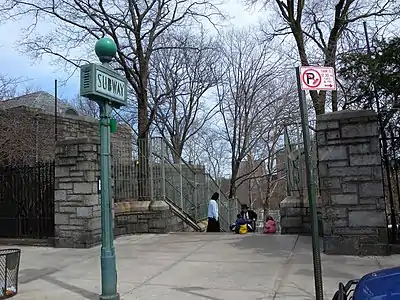 Fort Washington Avenue entrance
Fort Washington Avenue entrance Stairs to Fort Washington Avenue entrance
Stairs to Fort Washington Avenue entrance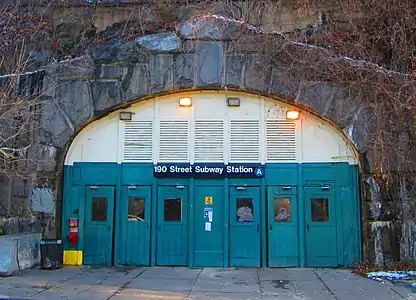 Bennett Avenue entrance
Bennett Avenue entrance
Notes
- By comparison, 34th Street–Hudson Yards is only 110 feet (34 m) below the surface, which is about 15 to 20 feet (4.6 to 6.1 m) above sea level.[49]
References
- "Glossary". Second Avenue Subway Supplemental Draft Environmental Impact Statement (SDEIS) (PDF). Vol. 1. Metropolitan Transportation Authority. March 4, 2003. pp. 1–2. Archived from the original (PDF) on February 26, 2021. Retrieved January 1, 2021.
- Young, Michelle (June 26, 2013). "The Deepest and Highest Subway Stations in NYC: 191st St, 190th Street, Smith & 9th". Untapped Cities. Archived from the original on April 3, 2018. Retrieved April 2, 2018.
- "List of the 28 Stations on the New 8th Av. Line". The New York Times. September 10, 1932. p. 6. ISSN 0362-4331. Archived from the original on May 2, 2021. Retrieved April 21, 2020.
- "Facts and Figures: Annual Subway Ridership 2014–2019". Metropolitan Transportation Authority. 2020. Retrieved May 26, 2020.
- "New York MPS 190th Street Subway Station (IND)". Records of the National Park Service, 1785 - 2006, Series: National Register of Historic Places and National Historic Landmarks Program Records, 2013 - 2017, Box: National Register of Historic Places and National Historic Landmarks Program Records: New York, ID: 75313905. National Archives.
- "Two Subway Routes Adopted by City". The New York Times. August 4, 1923. p. 9. ISSN 0362-4331. Retrieved August 1, 2019.
- "Plans Now Ready to Start Subways". The New York Times. March 12, 1924. p. 1. ISSN 0362-4331. Retrieved August 1, 2019.
- "Hylan Subway Plan Links Four Boroughs at $450,000,000 Cost". The New York Times. December 10, 1924. p. 1. ISSN 0362-4331. Archived from the original on June 14, 2018. Retrieved June 29, 2018.
- Raskin, Joseph B. (2013). The Routes Not Taken: A Trip Through New York City's Unbuilt Subway System. New York, New York: Fordham University Press. doi:10.5422/fordham/9780823253692.001.0001. ISBN 978-0-82325-369-2.
- "Express and Local Stations For New Eighth Avenue Line". New York Herald Tribune. February 5, 1928. p. B1. ISSN 1941-0646. ProQuest 1113431477.
- "Progress is Rapid on 8th Av. Subway; Board's Engineers Report Spurt in Building Is Likely to Open the Line in July, 1930". The New York Times. May 26, 1930. ISSN 0362-4331. Retrieved April 29, 2023.
- "Eighth Av. Subway Nearly Completed; Basic Construction Work From Chambers to 207th St. Done Except on Few Short Stretches". The New York Times. August 24, 1930. ISSN 0362-4331. Retrieved March 15, 2023.
- O'Brien, John C. (September 9, 1931). "8th Ave. Line Being Rushed For Use Jan. 1: Turnstile Installation on Subway Begins Monday; Other Equipment Ready for Start of Train Service City Has Yet to Find Operating Company Transit Official on Trip, 207th to Canal Street, Inspects Finished Tube". New York Herald Tribune. p. 1. ISSN 1941-0646. ProQuest 1331181357.
- "Sightseers Invade New Subway When Barricade Is lifted". The New York Times. September 9, 1932. ISSN 0362-4331. Archived from the original on July 1, 2022. Retrieved July 1, 2022.
- "8th Av. Subway Gets First 5c. by Woman's Error: She Peers Into a Station, Hears Train, Pays for Ride, but Is Day Too Early Preparing for Tomorrow's Rush on 8th Ave. Subway". New York Herald Tribune. September 9, 1932. p. 1. ProQuest 1125436641.
- Crowell, Paul (September 10, 1932). "Gay Midnight Crowd Rides First Trains In The New Subway: Throngs at Station an Hour Before Time, Rush Turnstiles When Chains are Dropped" (PDF). The New York Times. Retrieved November 8, 2015.
- Sebring, Lewis B. (September 10, 1932). "Midnight Jam Opens City's New Subway: Turnstiles Click Into Action at 12:01 A. M. as Throngs Battle for Places in 'First' Trains Boy, 7, Leads Rush At 42d St. Station City at Last Hails 8th Ave. Line After 7-Year Wait; Cars Bigger, Clean Transit Commissioner Officially Opening New Subway at Midnight". New York Herald Tribune. p. 1. ISSN 1941-0646. ProQuest 1114839882.
- Duffus, R. L. (September 9, 1932). "New Line First Unit In City-Wide System". The New York Times. p. 12. ISSN 0362-4331. Archived from the original on May 2, 2021. Retrieved August 3, 2017.
- Ronan, Thomas P. (December 29, 1950). "Subway Shelters to Cost $104,000,000 Proposed for City". The New York Times. p. 1. ISSN 0362-4331. Archived from the original on May 2, 2021. Retrieved August 3, 2017.
- Lister, Walter Jr. (December 29, 1950). "Subway Bomb Shelters Outlined, City Seeks U.S.Aid on Financing: Bingham Plans Sleeping Quarters for 101,500, Standing Room for a Million More". New York Herald Tribune. p. 1. ISSN 1941-0646. ProQuest 1327452864.
- O'Flaherty, Mary (January 5, 1957). "Stein's Plan For Subway Cash. Would Utilize Extensions For Shelters, Let U.S. Pay". New York Daily News. Archived from the original on July 12, 2019. Retrieved July 12, 2019.
- "190th St. Station Held Bomb-Proof". The New York Times. December 16, 1951. p. 65. ISSN 0362-4331. Retrieved July 30, 2016.
- "2 IND Elevators Open to Free Use". The New York Times. September 6, 1957. p. 19. ISSN 0362-4331. Retrieved July 30, 2016.
- Grynbaum, Michael M. (April 28, 2011). "The Subway's Elevator Operators, a Reassuring Amenity of Another Era". The New York Times. ISSN 0362-4331. Archived from the original on May 4, 2011. Retrieved August 3, 2017.
- Brachfeld, Ben (July 13, 2023). "Espaillat, TWU sue MTA over plan to stop staffing uptown subway elevators". amNewYork. Retrieved July 14, 2023.
- Waller, Nikki (November 23, 2003). "Why They Take the A Train (and the 1/9) – Neighborhood Report: Washington Heights". The New York Times. ISSN 0362-4331. Archived from the original on May 28, 2015. Retrieved August 3, 2017.
- Piazza, Jo (December 7, 2003). "M.T.A. Urged Not to Cut Elevator Jobs At 5 Stations". The New York Times. ISSN 0362-4331. Archived from the original on April 17, 2019. Retrieved August 3, 2017.
- Sanchez, Ray (December 8, 2003). "Deep Fears In Heights". Newsday. p. A02. ISSN 2574-5298. ProQuest 279797824.
- Luo, Michael (December 16, 2003). "Likely M.T.A Budget Cuts 22 Subway Elevator Operators' Jobs". The New York Times. ISSN 0362-4331. Retrieved July 13, 2023.
- Sangha, Soni (January 21, 2004). "Riders fear elevator cutbacks Operators not standing by". New York Daily News. p. 3. ISSN 2692-1251. ProQuest 305858845.
- Neuman, William (November 30, 2007). "M.T.A. Savings Proposal May Mean Service Cuts". The New York Times. ISSN 0362-4331. Archived from the original on December 11, 2008. Retrieved August 3, 2017.
- Gould, Joe; Nichols, Adam (December 1, 2007). "Subway Elevator Cuts a Downer, Say Riders". New York Daily News. p. 10. ISSN 2692-1251. ProQuest 306138699.
- Sangha, Soni (January 21, 2004). "Riders fear elevator cutbacks. Operators not standing by". New York Daily News. p. 87. Archived from the original on February 12, 2019. Retrieved February 11, 2019.
- "Changing Course, M.T.A. Will Keep Elevator Operators On". The New York Times. December 8, 2007. ISSN 0362-4331. Archived from the original on June 16, 2018. Retrieved August 3, 2017.
- Krisel, Brendan (October 31, 2018). "Uptown Subway Stations Won't Lose Elevator Operators, Union Says". Washington Heights-Inwood, NY Patch. Archived from the original on November 1, 2018. Retrieved November 1, 2018.
- Mocker, Greg (June 16, 2023). "Transit union and MTA debate future of elevator operators at Uptown subway stations". PIX11. Retrieved July 13, 2023.
- Simko-Bednarski, Evan (June 15, 2023). "MTA reassigning elevator operators deepest NYC subway stations". New York Daily News. Retrieved July 13, 2023.
- Saltonstall, Gus (July 13, 2023). "MTA Elevator Job Cuts Endanger Wash Heights Straphangers: Pol's Suit". Washington Heights-Inwood, NY Patch. Retrieved July 13, 2023.
- "Replacing the Elevators at Uptown A and 1 Stations". mta.info. Metropolitan Transportation Authority. Archived from the original on June 19, 2020. Retrieved August 4, 2020.
- Abramov, Nora; Mocker, Greg (December 18, 2018). "5 subway stations will get replacement elevators". WPIX 11 New York. Archived from the original on May 29, 2019. Retrieved December 19, 2018.
- "Five Subway Stations in Upper Manhattan to Receive New Elevators". mta.info. Metropolitan Transportation Authority. December 18, 2018. Archived from the original on December 19, 2019. Retrieved December 18, 2018.
- "MTA completes elevator replacements in upper Manhattan. For Railroad Career Professionals". Progressive Railroading. Retrieved April 30, 2023.
- Dougherty, Peter (2006) [2002]. Tracks of the New York City Subway 2006 (3rd ed.). Dougherty. OCLC 49777633 – via Google Books.
- "A Subway Timetable, Effective June 26, 2022". Metropolitan Transportation Authority. Retrieved August 26, 2023.
- "Tile Colors a Guide in the New Subway; Decoration Scheme Changes at Each Express Stop to Tell Riders Where They Are". The New York Times. August 22, 1932. ISSN 0362-4331. Archived from the original on July 1, 2022. Retrieved July 1, 2022.
- Carlson, Jen (February 18, 2016). "Map: These Color Tiles In The Subway System Used To Mean Something". Gothamist. Retrieved May 10, 2023.
- Gleason, Will (February 18, 2016). "The hidden meaning behind the New York subway's colored tiles". Time Out New York. Retrieved May 10, 2023.
- Rosenfeld, Robbie (August 13, 2015). "Uptown ramp". nycsubway.org. Archived from the original on April 2, 2018. Retrieved April 2, 2018.
- Flegenheimer, Matt (May 29, 2014). "With New Slant on Subway Elevators, Expect Delays". The New York Times. Archived from the original on May 30, 2014. Retrieved May 29, 2014.
- Castillo, Wilfredo (December 29, 2012). "Stairs down". nycsubway.org. Archived from the original on April 2, 2018. Retrieved April 2, 2018.
- Weinberg, Brian (May 14, 2009). "190 St station entrance @ Bennett Ave & W 193 St. Looking west up the tunnel towards the platforms". nycsubway.org. Archived from the original on April 2, 2018. Retrieved April 2, 2018.
- Cox, Jeremiah (March 7, 2013). "The area behind the high exit turnstiles from the uptown platform (the underpass is how silly passengers wanting to go one stop can enter the station)". subwaynut.com. Archived from the original on April 3, 2018. Retrieved April 2, 2018.
- "MTA Neighborhood Maps: Washington Heights" (PDF). Metropolitan Transportation Authority. 2015. Archived (PDF) from the original on April 18, 2016. Retrieved July 29, 2016.
- David-Paul, David (June 12, 2009). "Downtown sign pointed customers to directly enter 207th Street bound platform without using mezzanine area. Ramp is now exit-only". nycsubway.org. Archived from the original on April 2, 2018. Retrieved April 2, 2018.
- Husband, Timothy (2013). Creating the Cloisters. Metropolitan Museum of Art. ISBN 9781588394880. Archived from the original on May 2, 2021. Retrieved November 23, 2020.
- "Free Elevators in Subway Fought". The New York Times. August 7, 1939. p. 13. ISSN 0362-4331. Retrieved July 29, 2016.
- Kurtz, Josh (August 12, 1991). "Washington Heights Journal; A Subway Passageway Just for the Courageous". The New York Times. ISSN 0362-4331. Archived from the original on November 17, 2020. Retrieved July 30, 2016.
- Grynbaum, Michael M. (April 28, 2011). "The Subway's Elevator Operators, a Reassuring Amenity of Another Era". The New York Times. ISSN 0362-4331. Archived from the original on May 4, 2011. Retrieved February 14, 2017.
- "Accessible Stations in the MTA Network". Metropolitan Transportation Authority. Archived from the original on April 5, 2020. Retrieved March 8, 2010.
- Rosenfeld, Robbie (August 13, 2015). "Emergency Stairs". nycsubway.org. Archived from the original on April 2, 2018. Retrieved April 2, 2018.
External links
- nycsubway.org – IND 8th Avenue: 190th Street/Overlook Terrace
- Station Reporter — A Lefferts
- Station Reporter — A Rockaway
- The Subway Nut — 190th Street
- Fort Washington Avenue entrance from Google Maps Street View
- Bennett Avenue entrance from Google Maps Street View
- Platform from Google Maps Street View




